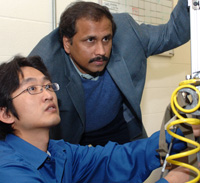Aug
31
Solar Power Water Splitting Catalyst Found
August 31, 2011 | Leave a Comment
A team of scientists from the University of Kentucky and the University of Louisville has determined that an alloy formed by a 2 percent substitution of antimony in gallium nitride has the right electrical properties to enable solar light energy to split water molecules into hydrogen and oxygen. The technical description is called the photoelectrochemical electrolysis of water or “photolysis” for a shortened term.
Using state-of-the-art theoretical computations, the UK – U of L team demonstrated that an alloy formed by a 2 percent substitution of antimony (Sb) in gallium nitride (GaN) has the right electrical properties to enable solar light energy to split water molecules into hydrogen and oxygen. The paper published this month in the Physical Review Journal.
Mahendra Sunkara, a professor of chemical engineering in the University of Louisville explains the first barrier, “Most of the materials we know of corrode in water; they can’t absorb light and still be stable during photolysis of water. So what we want is a material that is stable, can absorb visible light and can allow this water splitting to happen. By stability, we mean something that holds up for at least a few days to start off with, and eventually something that can last a few years.”
The next challenge is to create thin sheets of densely packed solar-converting devices that can cover large areas.
The team says in the circulating press release their findings are a triumph for computational sciences, one that could potentially have profound implications for the future of solar energy.
The team has determined that an inexpensive semiconductor material, gallium nitride, can be “tweaked” to generate hydrogen from water using sunlight. An alloy formed by a 2 percent substitution of antimony in gallium nitride has the right electrical properties to enable solar light energy to split water molecules into hydrogen and oxygen.
Professor Madhu Menon at the UK Center for Computational Sciences discusses the team’s positioning, “Previous research on photolysis has focused on complex materials. We decided to go against the conventional wisdom and start with some easy-to-produce materials, even if they lacked the right arrangement of electrons to meet photolysis criteria. Our goal was to see if a minimal ‘tweaking’ of the electronic arrangement in these materials would accomplish the desired results.” That’s the Edison method – and this time it has worked.
Gallium nitride is a semiconductor that has been in widespread use to make bright-light LEDs since the 1990s. Antimony is a metalloid element that has been in increased demand in recent years for applications in microelectronics. The GaN-Sb alloy is the first simple, easy-to-produce material to be considered a candidate for photolysis water splitting.
The alloy functions as a catalyst in the photolysis reaction, meaning that it is not consumed and may be reused indefinitely. U of L and UK researchers are currently working toward producing the alloy and testing its ability to convert solar energy to hydrogen. Efficiency rates will be intensely interesting numbers.
Sunkara says the GaN-Sb alloy has the potential to convert solar energy into an economical, carbon-free source for hydrogen. Today it takes a large amount of electricity to generate hydrogen by electrolysis or at commercial scale, most of the hydrogen manufactured today is derived from non-renewable sources such as coal and natural gas.
Sunkara said, “Once this alloy material is widely available, it could conceivably be used to make zero-emissions fuel for powering homes and cars and to heat homes.”
Menon says the research should attract the interest of other scientists across a variety of disciplines,
“Photocatalysis is currently one of the hottest topics in science. We expect the present work to have a wide appeal in the community spanning chemistry, physics and engineering.”
This is exciting news. An economically efficient home sized hydrogen production unit powered by solar would offer choices – hydrogen fuel cell to electricity, direct combustion to heat and perhaps fueling personal transport.
The research has a long way to go. As noted the alloy will need to last a long time free from corrosion be efficient enough to be economically competitive. The photolysis door is opened now – let the research and innovation pour through.


